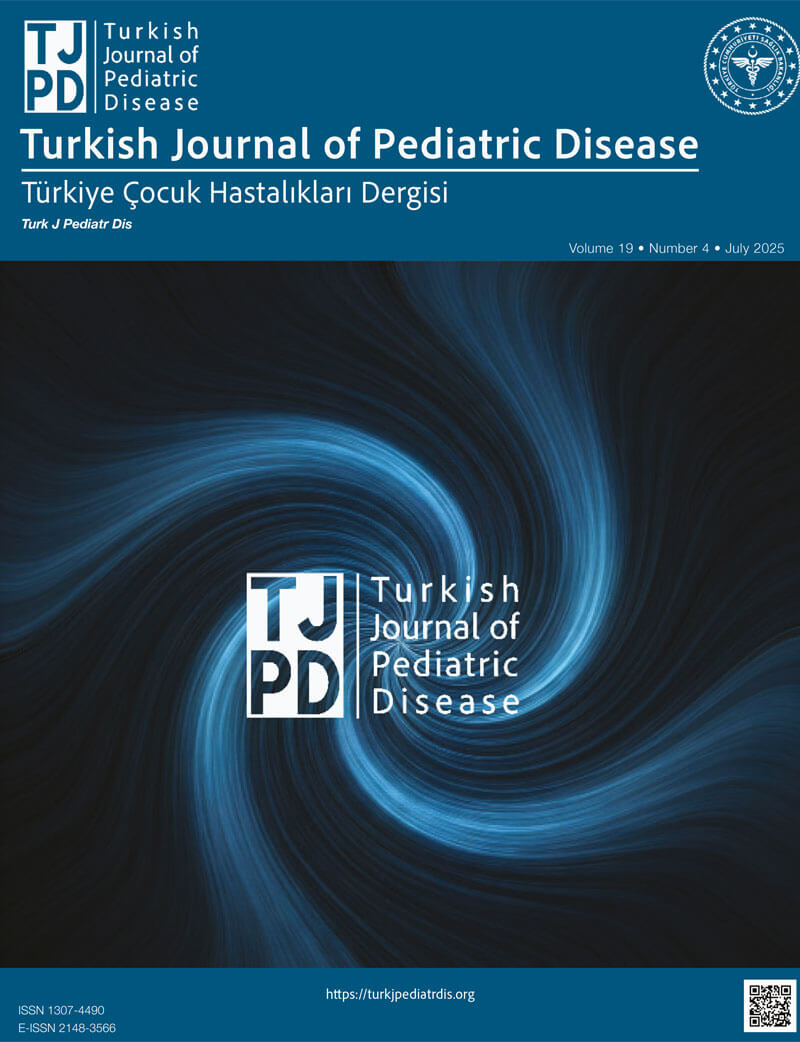Abstract
Objective: Familial hypomagnesemia with hypercalciuria and nephrocalcinosis (FHHNC) is a rare autosomal-recessive renal tubular disorder. It is characterized by renal wasting of magnesium and calcium, which subsequently leads to bilateral nephrocalcinosis, renal stones, and kidney failure. Early diagnosis of FHHNC is important to prevent morbidity and mortality but due to non-specific symptoms it is difficult to diagnose. In this report, pediatric FHHNC patients are presented to raise awareness about the disease.
Material and Methods: We retrospectively analyzed pediatric FHHNC patients in our hospital between 2010 and 2020.
Results: A total of seven patients, five girls (71.4 %) and two boys (28.5 %) with a median age of four years (min: four months, max:13 years) and a mean follow-up time of 4.4±3.5 years were included. Three patients had been diagnosed incidentally. All patients had nephrocalcinosis, hypercalciuria and high parathormone (PTH) level. One patient had normal serum magnesium level. All patients had high urine fractional excretion of magnesium (FEMg). Five patients had CLDN 16 mutation, and two patients had CLDN19 mutation. None of them had ocular findings. Three patients had kidney failure at the end of the follow-up.
Conclusion: Normal serum magnesium levels do not rule out FHHNC. FEMg value is much more significant in patients with FHHNC. FEMg is recommended in all pediatric patients with nephrocalcinosis even if serum magnesium levels are normal.
Keywords: CLDN16, CLDN19, Hypomagnesemia, Hypercalciuria, Nephrocalcinosis
References
- Hou J. Claudins and mineral metabolism. Curr Opin Nephrol Hypertens. 2016;25(4): 308-13. https://doi.org/10.1097/ MNH.0000000000000239
- Wang SB, Xu T, Peng S, Singh D, Ghiassi-Nejad M, A.Adelman R, et al. Disease-associated mutations of claudin-19 disrupt retinal neurogenesis and visual function. Commun Biol. 2019; 25; 2:113. https://doi.org/10.1038/s42003-019-0355-0
- Claverie Martin F. Familial hypomagnesaemia with hypercalciuria and nephrocalcinosis: Clinical and molecular characteristics. Clin Kidney J. 2015; 8: 656-64. https://doi.org/10.1093/ckj/sfv081
- Awazu M, Matsumura K. Utility of fractional excretion of magnesium in diagnosing renal magnesium wasting in pediatric nephrology practice. Clin Biochem. 2024 ;131-132: 110807. https://doi. org/10.1016/j.clinbiochem.2024.110807
- Gragossian A, Bashir K, Friede R. Hypomagnesemia. In: StatPearls (Internet). Treasure Island (FL): StatPearls Bookshelf ID: NBK500003; 2022. Available from: https://www.ncbi.nlm.nih.gov/ books/NBK500003/
- Al Ghali R, El-Mallah C, Obeid O, El-Saleh O, Smail L, Haroun D. Urinary minerals excretion among primary schoolchildren in Dubai- United Arab Emirates. PLoS One. 2021;16(8): e0255195. https:// doi.org/10.1371/journal.pone.0255195
- Sadeghi Bojd S, Narouie B, Mohammadi M. Normal Value of Random Urinary Calcium to Creatinine Ratio in Children in Zahedan, South-East of Iran. Health Scope. 2020; 9(4): e62433. https://doi. org/10.5812/jhealthscope.62433
- Nwosu IF, Ibeson CE, Olawoye A, Kyaw H, Kumar K, Odigve C, et al. Interpretation of Parathyroid Hormone Levels in Renal Impairment. Cureus. 2022; 14(6): e25819. https://doi.org/10.7759/ cureus.25819
- National Kidney Foundation. K/DOQI clinical practice guidelines for bone metabolism and disease in chronic kidney disease. Am J Kidney Dis. 2003; 42(4-3): 1-201. https://doi.org/10.1016/S0272- 6386(03)00905-3
- Fathallah-Shaykh SA, Cramer MT. Uric acid and the kidney. Pediatr Nephrol. 2014; 29: 999-1008. https://doi.org/10.1007/s00467- 013-2549-x
- Srivastava T, Winston MJ, Auron A, Alon US. Urine calcium/citrate ratio in children with hypercalciuric stones. Pediatr Res. 2009; 66(1): 85-90.https://doi.org/10.1203/PDR.0b013e3181a2939e
- Schwartz GJ, Brion LP, Spitzer A. The use of plasma creatinine concentration for estimating glomerular filtration rate in infants, children, and adolescents. Pediatr Clin North Am. 1987; 34(3): 571-90.https://doi.org/10.1016/S0031-3955(16)36251-4
- Vall-Palomar M, Madariaga L, Ariceta G. Familial hypomagnesemia with hypercalciuria and nephrocalcinosis. Pediatr Nephrol. 2021; 36(10): 3045-55.https://doi.org/10.1007/s00467-021-04968-2
- Sikora P, Zaniew M, Haisch L, Pulcer B, Szczepanska M, Moczulska A, et al. Retrospective cohort study of familial hypomagnesaemia with hypercalciuria and nephrocalcinosis due to CLDN16 mutations. Nephrol Dial Transplant. 2015; 30(4): 636-44.https:// doi.org/10.1093/ndt/gfu374
- Weber S, Schneider L, Peters M, Misselwitz J, Rönnefarth G, Böswald M, et al. Novel paracellin-1 mutations in 25 families with familial hypomagnesemia with hypercalciuria and nephrocalcinosis. J Am Soc Nephrol. 2001; 12:(9): 1872-881. https://doi. org/10.1681/ASN.V1291872
- Marumoto H, Sasaki T, Tsuboi N, Ito T, Ishikawa M, Ogura M, et al. Kidney disease associated with anorexia nervosa: A case series with kidney biopsies. Kidney Med. 2020; 2(4);418-24. https://doi. org/10.1016/j.xkme.2020.03.007
- Konrad M, Hou J, Weber S, Dötsch J, Kari JA, Seeman T, et al. CLDN16 genotype predicts renal decline in familial hypomagnesemia with hypercalciuria and nephrocalcinosis. J Am Soc Nephrol. 2008 ;19(1): 171-81. https://doi.org/10.1681/ASN.2007060709
- Faguer S, Chauveau D, Cintas P, Tack I, Cointault O, Rostaing L, et al. Renal, ocular, and neuromuscular involvements in patients with CLDN19 mutations. Clin J Am Soc Nephrol. 2011; 6(2): 355-60. https://doi.org/10.2215/CJN.02870310
- Prot-Bertoye C, Houillier P. Claudins in renal physiology and pathology. Genes (Basel). 2020; 11: 290. https://doi.org/10.3390/ genes11030290
- Vall-Palomar M, Burballa C, Claverie-Martín F, Meseguer A, Ariceta G. Heterogeneity is a common ground in familial hypomagnesemia with hypercalciuria and nephrocalcinosis caused by CLDN19 gene mutations. J Nephrol. 2021; 34(6): 2053-62. https://doi. org/10.1007/s40620-021-01054-6
- Zimmermann B, Plank C, Konrad M, Stöhr W, Gravou-Apostolatou C, Rascher W, et al. Hydrochlorothiazide in CLDN16 mutation. Nephrol Dial Transplant. 2006; 21(8): 2127-32. https://doi. org/10.1093/ndt/gfl144
Copyright and license
Copyright © 2025 The Author(s). This is an open access article distributed under the Creative Commons Attribution License (CC BY), which permits unrestricted use, distribution, and reproduction in any medium or format, provided the original work is properly cited.






